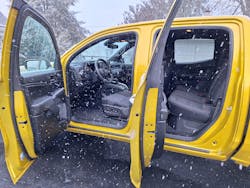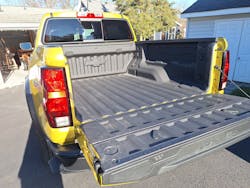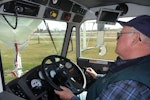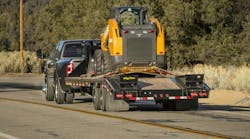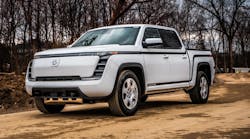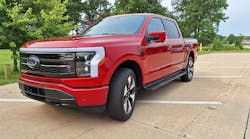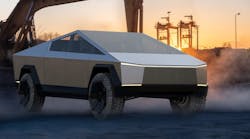As pickup trucks keep increasing in size, many may wonder if they’re really needed. Would something smaller work better, or at least as well? It would save money and be easier to drive around town. An example is the Chevrolet Colorado crewcab 4x4 that I tested for a week. It was a kick to drive, thanks to its lively powertrain, decent comfort, and handy size.
Published length and width dimensions show that a Colorado is roughly nine-tenths the size of a crewcab Silverado. Put another way, a Colorado is 10% smaller, but it feels more like 20 percent while driving. Turning sharp corners and slipping in or out of parking-lot slots was easy, whereas a full-size pickup can be clumsy. And depending on equipment, a Colorado weighs 200 to 1,000 pounds less.
Read also: ICE Dominates Pickups, but Electrics Proliferate
Today’s full-size pickups—the popular half-tonners like Ford’s F-150, and the Ram and Chevy/GMC 1500s—have become large and heavy. And for what? Surveys show that few big pickups actually carry the loads or pull the trailers that they’re built for. For instance, only 27% of owners use their pickups for hauling and just 7% tow anything. Most folks use their trucks for personal transportation, period.
The Colorado can carry people and stuff, too, though not as much. The Trail Boss version shines off road, with a high stance and tall ground clearance. Its front-driving axle, 2-speed transfer case, beefy tires, and flexible suspension could probably challenge impossibly rugged terrain. I took it to the nearby county fairgrounds and gave it a light workout, crawling sure footedly up and down a steep slope covered by wet grass. I banged through potholes and looked for broken pavement to roar across, and decided that I’d want this truck if I lived in the boonies at the end of a long, rough driveway.
On pavement, the Trail Boss’s stiff suspension remains useful for hopping over speed bumps and high-crowned railroad crossings, but it also accentuated pavement irregularities and reminded me that this was, indeed, a truck.
I ran everyday errands and took it on a 150-mile trip where I picked up a large box that would have fit easily into the back of my SUV but was awkward with the pickup: I didn’t want to put the box in the bed because I neglected to bring along tie-down straps. With some help, I stuffed it through the back door. It had to rest on the upholstered rear seat because it doesn’t adjust to present a cargo-carrying space.
The seat bottom can be lifted to access a jack and associated tools, which lay in a plastic pocket, but there’s no platform. The seat back doesn’t pull down to make a shelf, either. Apparently, Chevy designers believe that a back seat is for people, not stuff. That limits utility: There are some items you don’t want to put in the bed, like my big box and maybe your tools.
Read also: Rear Seat Passengers May be at Risk in Pickups
The high stance puts the cab floor 22 inches off the ground, and short people like me have trouble climbing inside. There’s no handle on the A-pillar (though there is one for the front-seat passenger), so I placed my right foot on the floor, grasped the steering with both hands and pulled myself in. Running boards or outside steps would certainly help.
Once inside, I faced a pair of colorful glass displays, one directly ahead for virtual gauges—warning lights and the like—and another in the dash’s center, which was a touch screen for multiple functions—map and navigation, radio settings and broadcast info, images from the backup camera, headlights. Headlights? Right. Instead of a tried-and-true push-pull or rotary switch for the headlamps, you touch the screen several times before finding controls. Among them is auto-on and -off, which I enabled to eliminate all the punching.
Thankfully, HVAC controls were actual switches. They’re too small for easy use, but OK once I learned where each was. I mentally griped that air-flow buttons included one for floor, another for vent (face) but none for both, until I discovered that both can be engaged at the same time. Oh.
The switch for the emergency flashers was hard to find, as its little red triangle was not visible in daylight. I thought the switch had been omitted, so I stopped at Reichard Buick-GMC (who sell the Canyon, Colorado’s twin), and they showed me it was where it was supposed to be, along the base of the dash. It does light up at night. Oh.
That dealer is in Dayton, Ohio, and one of the salesmen who helped me was Jeff Reichard, the down-to-earth owner. I told him I liked the Colorado primarily for its size, and wondered why full-size pickups like the GMC Sierra and Chevy Silverado are so much more popular.
“Well,” he said, “let’s say you have kids to haul around, and kids are always bigger than their parents and they’ve got long legs. But they’ll fit right in the back seat of a Sierra and be comfortable. You can’t do that in a mid-size pickup.”
Reichard said Sierras and Silverados outsell Canyons and Colorados by seven to one. GM builds the full-size models at three plants, but only one factory makes the smaller trucks, so dealers’ lots are stocked with plenty of the bigger pickups but far fewer of the others. Production follows popularity, though, because full-size pickups are what most buyers want. Most of them have V-8 engines, which aren’t needed in the mid-size Colorado.
It had a 31-horsepower 2.7-liter turbocharged inline four, which was gutsy if not overly easy on gasoline (EPA rates this 4x4 version at 17 city, 21 highway). The turbo masked the anemic buzzing that most four-cylinder engines produce, so the engine sounded strong and was. All thoses horses stampeding from under the bulky hood authoritatively accelerated the truck and quickly moved me around fuddy-duddy vehicles on two-lane highways. In the process, rpm reached 5,000 and 6,000 on the tachometer as the 6-speed automatic briskly downshifted two or three gears.
The 2.7 Turbo engine also comes in a 237-horsepower rating for the WT (Work Truck) and LT models of the Colorado (about 2 mpg higher overall). In addition to the Trail Boss, the 310 rating goes into ZR1 and ZR2 models. There are five trim/equipment levels, but only one type of cabin: a four-door crewcab, because that’s what most folks want these days. There are still buyers for regular and extended cabs in the larger pickups, so they remain available.
Colorado means red in Spanish, but my truck was painted a mustard-like Nitro Yellow that I got to like. Maybe it’ll become a high-visibility alternative to the Omaha Orange we see on so many municipal trucks, and it certainly stands out better in photos than common blah-white. Color aside, if I needed a pickup, a mid-sizer like this would be my choice.

